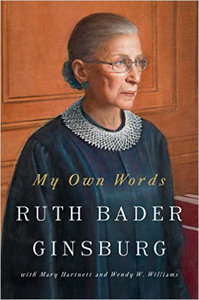 Ruth Bader Ginsburg, with Mary Hartnett and Wendy W. Williams, My Own Words (New York: Simon and Schuster, 2016), 371pp.
Ruth Bader Ginsburg, with Mary Hartnett and Wendy W. Williams, My Own Words (New York: Simon and Schuster, 2016), 371pp.
When Ruth Bader Ginsburg (b. 1933) entered law school in 1956, women comprised about 3% of the law profession. Today they comprise half of law school students and over a third of our federal judges. Beginning in the 1970s, few people have been more responsible for that remarkable sea change than Ginsburg herself. She was one of the foremost litigators before the Supreme Court on gender equality, a founder of the ACLU's Women's Rights Project, and so earned the moniker the "Thurgood Marshall of the women's movement."
In 1993, Bill Clinton nominated her to become a Supreme Court Justice. In our own politically divisive days, it's shocking to read how the Judiciary Committee voted 18-0 to send her candidacy to the Senate, which in turn approved her nomination by a vote of 96-3. It was a well-deserved lovefest. Across the ensuing years, she's become "the liberal minority's most senior Justice."
This book isn't a biography, as I mistakenly thought when I checked it out of the library. Rather, it's a collection of her writings — speeches, briefs, articles, letters, etc., collected by two law professors whom Ginsburg has chosen as her (future) authorized biographers. There are five main sections to the book: her early years, tributes to waypavers, women and the law, becoming a Justice, and then her role on the Supreme Court. After a brief introduction by Ginsburg, Hartnett and Williams introduce each major section and individual chapter with background information and historical context.
Those like me who aren't used to reading legal arguments might find some of the reading heavy sledding, but there were nonetheless numerous enjoyable takeaways. Ginsburg and Scalia enjoyed a deep and genuine friendship despite their differences, based upon a deep reverence for the institution they served. I liked her section on the wives of Justices — a very characteristic honoring of those we often ignore by Ginsburg. She and her husband Marty doted on each other across a marriage of 56 years. The sheer workload of the court is amazing — about 6500 petitions for review every year, with about 80 full briefs and arguments that lead to opinions. Finally, and again despite the divisive stereotypes of our day, most of the Supreme Court cases are not decided by narrow majorities. There's far more collegiality and agreement — "In recent Terms, the Court has ruled unanimously, at least as to the bottom line judgment, in about 40 percent of the argued cases… In contrast, the Court divides sharply, 5-4, in fewer than 25 percent of the argued cases."
No wonder that among her many awards and honors, in 2016 Forbes named Ginsburg one of the "World's Greatest Leaders."


